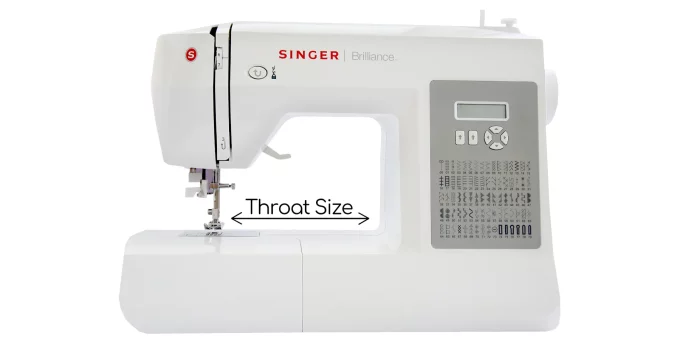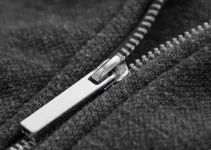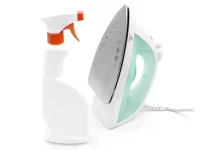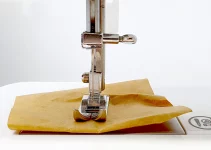By looking for large throat sewing machines for quilting we’re moving into the world of models that are mostly called sewing & quilting machines.
Just like we have sewing & embroidery machines, which you can check out in my articles reviewing the best cheap embroidery machines and the best embroidery machine for beginners, so we have sewing & quilting models.
However, some of these machines that are made for sewing and quilting don’t have unusually large throats. They look just like normal sewing machines that are mostly used for making clothes and sewing through various fabrics, including leather, and for mending clothes.
And I’m going to recommend quite a few of those because I believe that we can find some of the best quilting sewing machines among them, even if their workspace is not the biggest.
Thus, we can certainly get quilting machines that have a pretty normally sized throat. And sew amazing projects with their help.
I understand that we’re here to look for large throat sewing machines for quilting. And I totally get why you would need to look for models with a big throat space or a big workspace area.
Plus, I’m totally going to review some pretty interesting large throat sewing machines for quilting. But we’re also going to include some standard workspace looking ones because those can be awesome, as well.
Also, if you’re interested, check out my recommendations for the best sewing chair. Check out my recommendations for the best spray starch for ironing because some can make quilting easier.
Large Throat Sewing Machines for Quilting Reviews
When it comes to large throat sewing machines, there are a few things I want you to consider.
Mainly, I want you to take into account that these generous models, with a very large space to the right of the needle, can be extremely expensive.
Let’s take the Janome M7 Continental and Quilter’s Collector Series as an example. Here we have a machine that costs around $9,000. Indeed, we get 13 ½ inches of work space and a total work area of 17.81 inches. But we have to pay serious money for those kinds of features.
The same goes for the Pfaff Performance Icon.
Another example is the Brother Luminaire XP2, which is even more expensive than the Janome M7. It has a large throat without a doubt, we get 13.1 inches from needle to arm. And it’s also an embroidery machine. But we must pay over $10,000 for such an accomplished machine.
Another extremely expensive large throat model is the Baby Lock Solaris Vision.
I’m not in the habit of reviewing and recommending such expensive models. If you want to spend that kind of money, you already have my top 4 recommendations that you can check out: Janome M7, Brother Luminaire XP2, Baby Lock Solaris Vision, and Pfaff Performance Icon.
On the other hand, if you’re willing to settle on something less extraordinary, then stick around and you’ll come across models that cost $2,000, $1,000, $500 or less. In the end, how much you’re willing to spend will greatly influence your final pick for large throat sewing machines for quilting.
What I can guarantee is that we’re going to review some of the best sewing & quilting machines.
1. Janome MC6650: One of the Best Large Throat Sewing Machines for Quilting
If you are looking for large throat sewing machines for quilting but your budget is just slightly under $2,000 and not in the $10,000+ range as we saw with the examples I gave you above, then you might be interested to know more about the Janome MC6650.
Overall the Janome MC6650 is one of the best sewing & quilting machines and the throat space is pretty nicely sized.
However, there are quite a few negative reviews that you should check out before deciding if this Janome model is the right one for you or not.
Overall, Janome is a great brand and one of their machines was among my favorites when I gave my recommendations for the best sewing machine for leather.
But it’s not a manufacturer that makes affordable machines. If you’re looking for options that cost $500 or less, you need to check out the Brother and Singer models that I will review just below.
Let’s see what the Janome MC6650 offers to potential buyers.
Throat space
This Janome comes with a 10 inch All-Metal Seamless Flatbed.
Thus, the throat space measures 10 x 4.7 inches, which is quite impressive. Of course, the expensive price for this Janome totally implies that their workspace should be quite big.
A 10 inches throat space is not the largest but it still allows the Janome MC6650 to perfectly qualify as one of the best large throat sewing machines for quilting.
It allows enough space to work freely and beautifully on large and small projects.
The manufacturer mentions that if we combine the large workspace with the speed and precision that the MC6650 offers, we get a machine that brings professional power into households.
170 stitches
We get a large number of stitches. And 2 alphabets.
Besides getting whatever type of stitches we will ever need, there’s another interesting thing about the MC6650.
The 1,000 stitches per minute speed is very nice. Heavy-duty models, like the Singer Heavy Duty 4423 can have a top speed of 1,100 stitches per minute but this Janome comes very close.
The thread tension control is manual.
Maximum stitch width is 9mm.
It comes with a top loading full rotary hook bobbin, which also led to me reviewing as an amazing drop-in bobbin sewing machine.
Features
It comes with superior needle threader. Thus, we get an automatic needle threader, which is totally common in machines that cost more than $150-$200.
What I like about the Janome MC6650 is that we also get an automatic thread cutter. An automatic thread cutter is not as common as an automatic needle threader has become.
Another feature that Janome is known for and that is also incorporated in the MC6650 is the foot pressure adjustment dial.
This sets the amount of pressure that the presser foot places on the fabric. It allows us to adjust the pressure when we need to switch between lightweight fabric and multiple layers of thick fabric so that we can feed the fabric evenly.
The speed control slider is another helpful feature. It allows us to set up our sewing speed from a button and we don’t have to worry about controlling our sewing speeds from the foot controller. That’s pretty great, it allows us much better control and ease of use, even for beginners.
We also get drop feed. That’s great for those who want to lower the feed dog out of the way for free motion sewing.
Of course, lowering the feed dog out of the way is highly important for quilting, monogramming, and embroidery.
Another feature that I really like is the presence of 6 LEDs in 3 locations. That’s a thoroughly illuminated sewing space.
Accessories
The Janome MC6650 includes plenty of accessories, which goes a long way to justify the price: automatic buttonhole foot, darning foot, free motion quilting closed toe foot, free motion quilting open toe foot, free motion quilting zig-zag foot, satin stitch foot, zig-zag foot, blind hem foot, overcast foot, zipper foot, rolled hem foot, clear view foot.
It’s perfectly clear that the MC6650 is a fantastic quilting sewing machine. And it’s one of my top recommendations for large throat sewing machines for quilting for people with a budget around $2,000.
The other accessories, besides those many feet, are: foot control, quilting guide bar, spool holder large (2), spool holder small (2), spool rest (2), net (2), seam ripper, lint brush, buttonhole stabilizer plate, straight stitch needle plate, bobbins (5), screwdriver, stitch reference chart, dust cover, instruction book.
There’s no knee lift.
2. Juki HZL-NX7 Next Generation Long Arm Sewing and Quilting Machine
Another expensive option as one of the best large throat sewing machines for quilting is this Juki.
If your budget is under $3,000, disregard this Juki from the start. I must admit that I prefer the Janome MC6650 simply because it’s at least $1,000 cheaper. It’s a considerable price difference.
However, this Juki does include a larger throat than that of Janome MC6650, which is something that can totally justify the higher price.
Throat space
Juki describes the HZL-NX7 as providing a wide sewing area.
Indeed, the 12 inch throat space is amazingly wide.
Given that the Janome M7 Continental and Quilter’s Collector Series has a 13.1 inch throat for a price around $9,000, I would say that Juki HZL-NX7 with its 12 inch throat and a third of that price can be quite a tempting model.
Plus, this Juki also gets an extension table, which is wonderful for a variety of projects.
315 stitches
An impressive 351 stitches lay at your disposal for quilting and any other sewing project you want to take on.
There are also 4 alphabetic & numeric fonts.
The max stitch length is 5mm.
Plus, I totally love the 1,050 stitches per minute speed for the HZL-NX7. That’s impressive.
Features
The color touch panel can be an awesome addition for those who want a lot of technology with their sewing & quilting machines.
We will use this touch panel to change settings for: thread tension, presser foot pressure, pivot function, drop feed system, adjust needle thread tension, and automatic thread trimming with one touch.
From this list of things we can adjust from the touch panel, we can easily see that Juki HZL-NX7 offers all the needed features for an impressive quilting and sewing machine with a large throat.
The list is complete and you’ll find everything you might need for successful projects of all types. Check out my reviews for the best sewing books if you need more inspiration.
The automatic thread trimming means that with the push of a button we can automatically trim the thread. It’s a nice feature that more expensive models nowadays include as a rule.
Of course, we get to lower the feed dogs for free motion quilting.
The presser foot pivot function allows us to sew corners or pivot with ease.
We also get the interchangeable straight stitch feed system. It allows us to switch to perfect straight stitch sewing with a revolutionary interchangeable Feed System.
Another interesting feature is the buttonhole sensor system. The system automatically measures and evenly sews on both the right and left sides to create beautiful buttonholes.
This Juki also comes with dual LED lighting to illuminate the 22.4 x 13.6 inches workspace with an addition of 2 lights over the needle for extra light.
Brightness level can be adjusted.
Accessories
The feet included are: standard presser foot, blind stitch presser foot, open toe presser foot, 7mm guide foot, zipper presser foot, buttonhole presser foot, patchwork presser foot, ¼” guide foot, overcasting presser foot, quilt presser foot.
The other accessories we get are: straight stitch throat plate, auxiliary spool pin, wide table, spool caps (small, medium, large), screwdriver, knee lifting level, manual buttonhole, quilting guide, cleaning swabs, foot controller, and machine case.
There are also some really useful optional accessories that I would have liked to have seen included among the standard accessories that come with this Juki. I think it would have been nice considering the price for this machine.
3. Brother PQ1500SL Sewing and Quilting Machine
With this one we’re descending from models that cost $2,000-$3,000 like the above Juki and Janome to models that cost $1,000 or less. It’s a big descent.
Of course, these types of affordable sewing & quilting machines look like normal sewing machines.
What I mean by that is that there’s no large throat of 10 or 12 inches.
Thus, if your budget is under $1,000, you really can’t expect an overly large workspace.
It’s not like this Brother PQ1500SL is exactly cheap but it definitely doesn’t compare with what the above Juki and Janome offer buyers.
Throat space
We get a fairly large or at least good enough 5.7 x 8.6 inches needle-to-arm space.
With the wide table, the workspace is expanded to 11 x 21.5 inches. Overall, it’s absolutely not a bad offer.
1 stitch
We only get the straight stitch so there are no hundreds of different stitch patterns to choose from.
No buttonholes either, which might be a bit of a disappointment for some. No zig-zag either. Or overstitch. Just straight stitching.
Brother PQ1500SL demonstrates that it’s focused on speed and on more room in the throat. That might be something that can work for you. It’s certainly very popular among quilters, including those with decades of experience.
Simply put, the PQ1500SL delivers an industrial machine to households.
It is heavy duty, can sew through heavyweight fabrics, and through numerous layers.
It’s incredibly fast but due to its weight it won’t move even when we’re sewing at top speeds.
You might believe that a machine that has only one stitch should be the cheapest thing possible. That’s absolutely not the case. This Brother is a clear example of that.
Another expensive model with just a straight stitch that I also recommended as one of the best sewing machines for making clothes is the Juki TL-2010Q.
What the Brother PQ1500SL boasts of is the 1,500 stitches per minute speed. That sounds amazing. It’s advertised for high-speed sewing & quilting.
However, there is a review from a buyer, an experienced seamstress in clothing, costuming and quills who mentions that this machine works in only 2 ways: we can do free motion quilting either slow or fast. That can make free motion quilting a challenge.
Plus, I want to mention that this Brother doesn’t come with a free motion quilting foot. But it will include quilting feet. And we can absolutely do free-motion quilting.
I should also clarify that the Brother PQ1500SL is one of the most highly rated sewing machines at the moment. And it’s also very popular, even with its price around $700-$800.
Features
Of course, we get an automatic needle threader.
The nice addition is the automatic thread cutter that is also included.
It also includes a precision pin feeding system to make it easier to sew a wider variety of fabric thickness.
There are also 4 feed dog height adjustments. It allows for free motion quilting.
Accessories
There are 7 feet included: general purpose foot, rolled hem foot, adjustable zipper/piping foot, invisible zipper foot, ¼” foot, spring action quilting foot, walking foot.
It doesn’t include the same number of sewing feet as models that cost 3-4 times more but that’s to be expected.
Other accessories are: knee lifter, extension table, screwdriver, cleaning brush, needles and case, fabric separator, feed pin, bobbin (5), spool cap, foot controller, soft cover.
It’s also a machine that you’ll have to oil for perfect, fluid sewing for many years to come.
4. JUKI TL-2000Qi Sewing and Quilting Machine
Another model in this price range under $1,000 is this TL-2000Qi from Juki.
Both this Juki and the above Brother share a lot of features, including the overall design of these industrial for households machines.
And they’re both highly popular and highly rated.
Throat space
The arm size is 8.5 x 6 inches. It seems to be the norm for models under $1,000.
The auxiliary table measures 23 x 13 inches.
1 stitch
Once again, we come across a sewing & quilting machine that only offers the straight stitch.
And the sewing speed is 1,500 stitches per minute, just like the Brother from above.
The minimum is 55 stitches per minute.
Features
It is described as being a 1-needle, lockstitch, portable sewing machine with automatic thread trimmer for quilting, tailoring, apparel, and home décor.
We can automatically trim both the needle and bobbin threads by pressing the heel side of the foot controller. It’s quite easy to get used to.
Moreover, there’s also a button for the automatic thread cutter. It is identified by a scissors icon and it is situated under the stitch length adjusting dial.
The foot controller is big enough so it’s easy to control sewing-start and -stop.
It’s quite versatile.
Obviously, we also get automatic needle threader. But some buyers have a bit of trouble getting used to this automatic needle threader. You can thread it manually if you don’t get used to it.
A knee lift lever is also included.
The speed control mechanism, operated by microcomputer, allows the JUKI TL-2000Qi to sew materials at low speeds. Of course, we can adjust the speed as we want.
It provides for accurate feed and perfect stitching when sewing heavy weight fabrics, quilting, and multiple layers of materials.
It’s clear that this Juki can handle some heavy tasks. And quilting is certainly a favorite craft for buyers of this Juki.
Juki mentions that it’s portable but at a weight of 25.4 pounds, I wouldn’t say that this is exactly lightweight for many of us. It’s certainly not a mini sewing machine.
It’s a machine made of metal so it’s obviously quite heavy.
This Juki is a heavy duty model that can sew through lots of heavy layers. It’s a workhorse model with a body made completely of metal.
It can be perfect for people who are looking for a reliable, affordable industrial machine for home use.
Accessories
We don’t get a lot. We get: presser foot and even feed foot.
There are a bunch of optional accessories we can buy.
The other accessories are: bobbins (4), needles, foot controller, auxiliary table, knee lift lever, sewing machine cover, screwdriver, oiler, spool cap, cleaning brush.
5. Singer 9960 Sewing & Quilting Machine
This Singer is certainly not the cheapest model we can buy for quilting and sewing. With a price around $500 it can be considered affordable.
However, if you’re looking for cheap models that cost around $200-$300, I recommend the Singer 7258 and Brother HC1850.
Throat space
This Singer 9960 resembles a regular sewing machine with a regular throat space, no large spaces in sight.
We get a 6.4 inch sewing space (needle to tower) and 4 inch height.
There’s also an extension table included.
1,172 stitch applications
There are 600 built-in stitches.
It can do pretty much anything we want. The number of stitch applications available are incredible.
It promises consistent buttonholes with 13 one-step buttonhole styles.
There are also 5 fonts included.
Features
We can use the needle up/down feature for easy pivoting like sewing on a pocket, top stitching, free-motion quilting, applique, etc.
The Speed Control feature allows us to set up the speed we need.
It can go faster for long seams or slower for more intricate projects. It’s certainly great at speed control.
We also get a built-in needle threader.
And a built-in thread cutter for trimming both the top and bobbin threads with the touch of a button.
The drop feed allows us to do whatever free motion sewing or quilting we want. Singer describes it as a must-have for quilters and I agree.
This 9960 weighs just 18.2 pounds so we could describe it as being portable.
Accessories
We get the following feet: general purpose foot, zipper foot, buttonhole foot, satin foot, blind hem foot, open toe foot, cording foot, darning/embroidery foot, even feed/walking foot, overcasting foot, button sewing foot, narrow hem foot, quarter inch foot.
The other included accessories are: quilting bar, pack of needles, bobbins, seam ripper, auxiliary spool pin, spool pin felt, thread spool caps, screwdrivers, large extension table, hard dust cover.
The Singer 9960 absolutely doesn’t disappoint when it comes to all these accessories it comes with.
What is a sewing machine throat?
It’s the free space at the right of the needle, up to the arm. It can also be simply called throat space or workspace area.
The throat of a sewing machine is the space between the upright arm, sewing head, horizontal arm, and the machine bed.
Some people are looking for large throat sewing machines for quilting because it allows us to sew bulky items, like a queen or king-size blanket.
We roll what we’re sewing in the throat and then we unroll the quilt as we sew. That’s why a large workspace can be so beneficial.
If we work on such large items and we cram them tightly into a small workspace that can lead to wrinkles and puckering.
Thus, searching for large throat sewing machines for quilting is necessary for crafters and sewers who frequently create large, bulky quilts but how much workspace we’re actually going to get will be majorly influenced by how much we can spend on such a machine.




